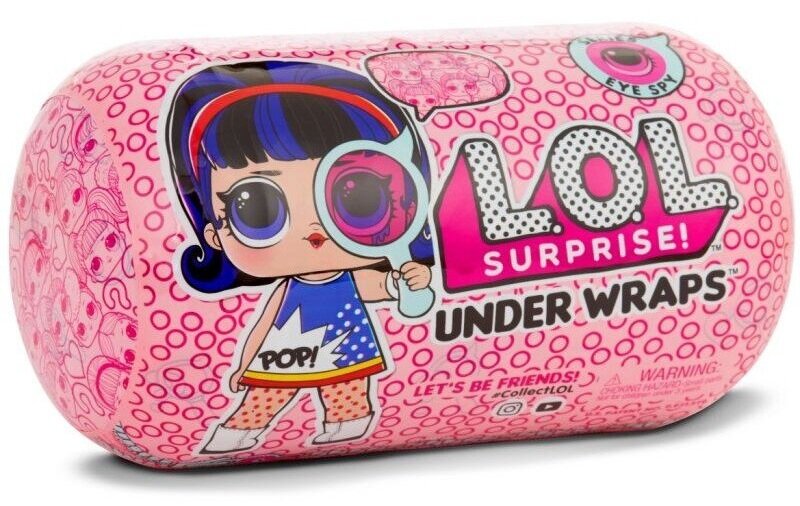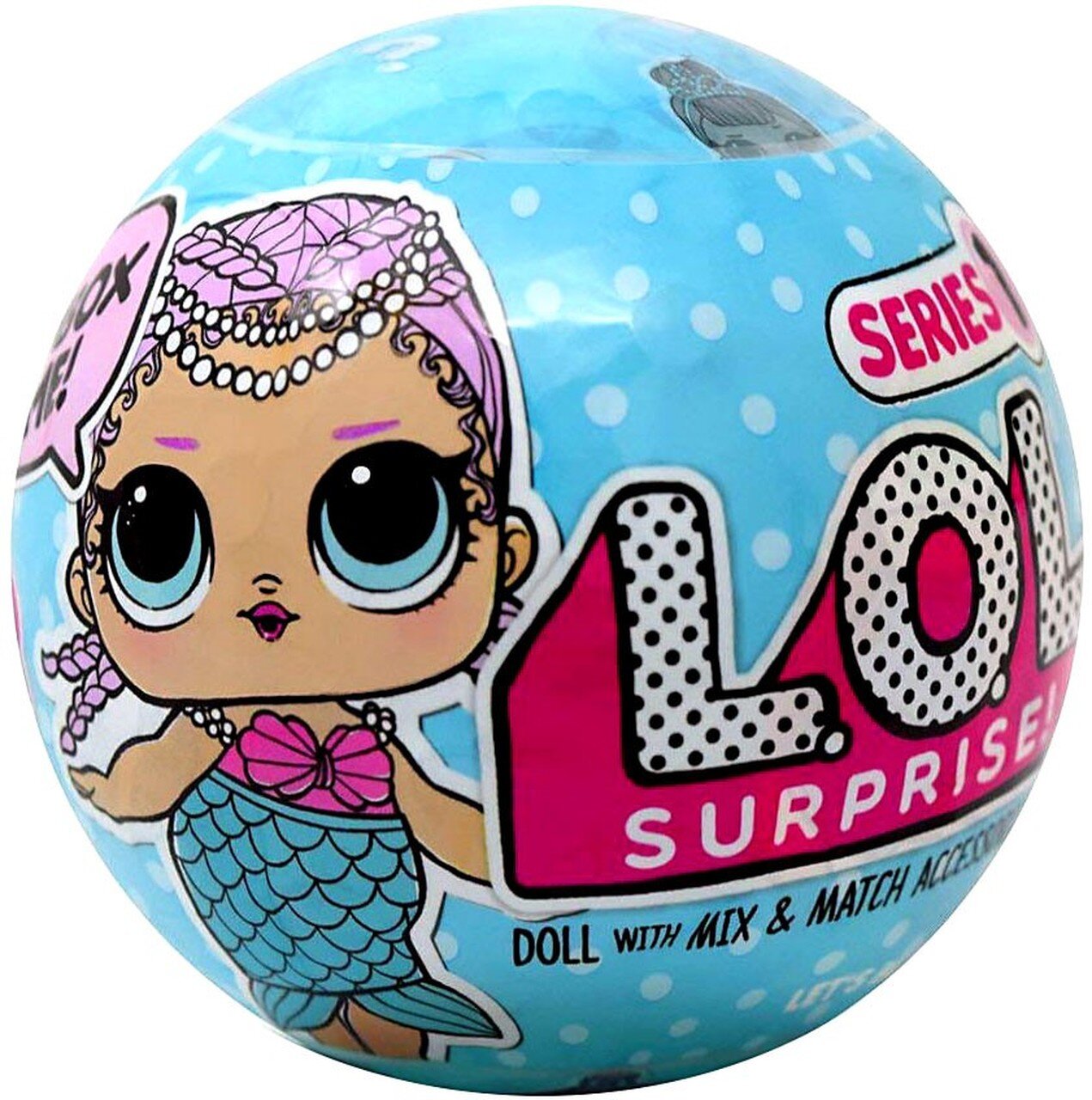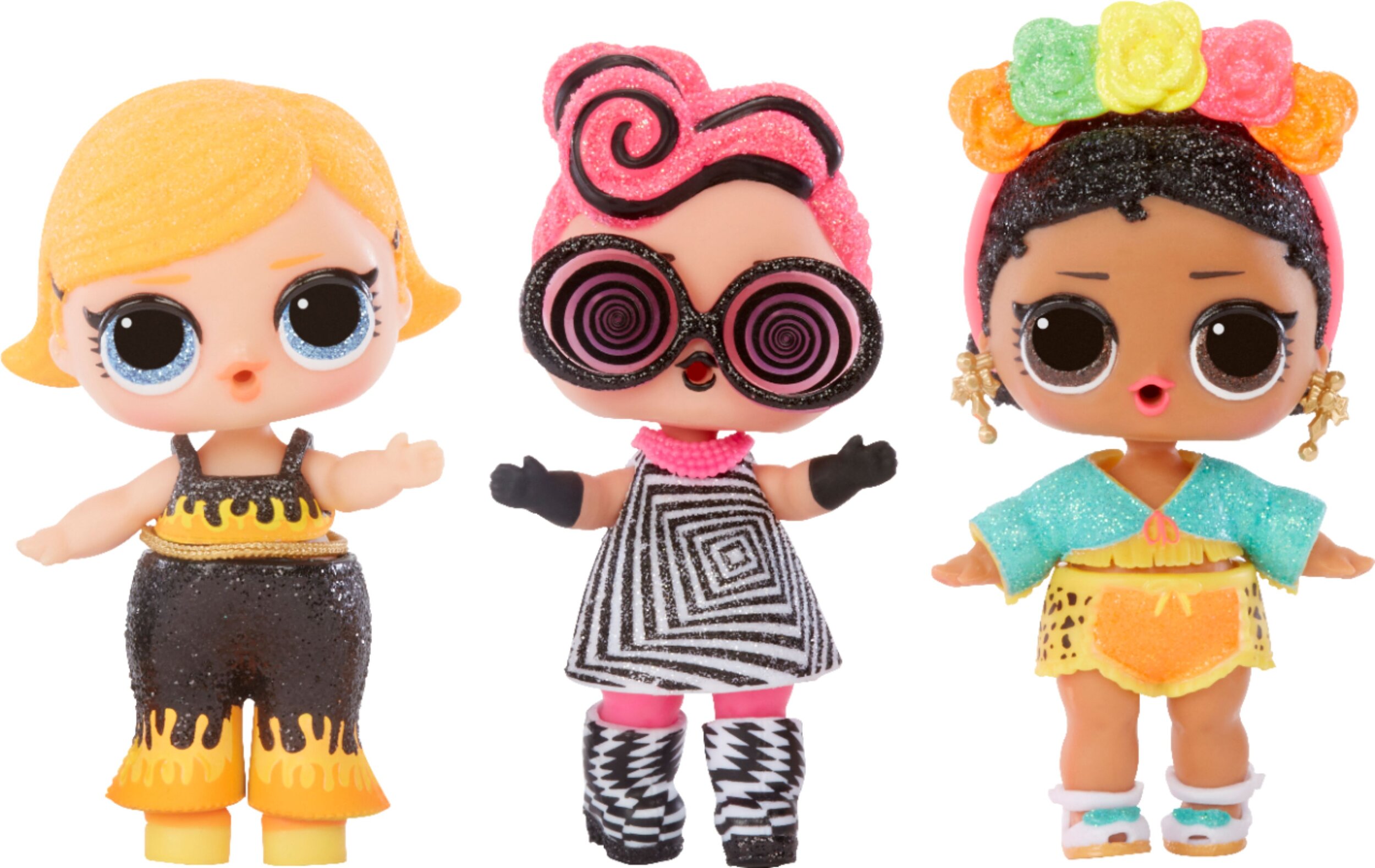SURPRISE! SURPRISE!
HOW L.O.L. SURPRISE! SPARKED A
MANIA OF EPIC PROPORTIONS
The Toy Sector
Over the years, leading toy makers have taken many twists and turns to garner popularity among youth audiences—introducing new technology, starting trends, and exploiting the prevailing cultural climate. From Atari 2600 to Beanie Babies to Tickle Me Elmo, Rubik’s Cubes, and Cabbage Patch Dolls, manufacturers have played on popular sentiments of the day in an effort to stimulate public frenzy. If the moment is right, the momentum drawn from that frenzy transforms into an all-out mania. The same sociological phenomena that once made My Little Pony and Care Bears must-have items appear to be at play in the current market with the meteoric rise of the L.O.L. Surprise brand; however, there are numerous contributing factors that make this particular toy line’s path to the top a case of great intrigue.
They say that hindsight is always 20/20. While we may pine to exploit the markets of our feeble-minded selves of yesteryear, the further we go into the future the more we find that everything has been hackneyed, and the more the market tends to be oversaturated with whatever is working at the moment. How then, we might ask—as many perplexed parents have also asked—has a toy so unassuming as L.O.L. Surprise, with its unremarkable plastic miniature figurines, found its way to the top of the toy food chain? The answer has to do with the fact that modern leading toy brands are often selling a whole lifestyle experience rather than merely the products themselves. Whether it be Nintendo Switch’s seamless transition from home to mobile, online gaming market arena, and its split controller sharing capabilities, or American Doll’s reverse product placement consumer integration strategy, both brands and consumers in the toy space have come to prioritize experience in a new way in recent times. To understand how this plays into L.O.L. Surprise we must examine the brand’s market activity and the context under which it came into its current status.
POINTS OF ORIGIN
Image by MGA Entertainment
MGA Entertainment was founded in 1979 and has since that time expanded to become the world’s largest independent toy manufacturer. The company was vaulted to the upper echelons of the toy sector with the introduction of its wildly successful Bratz line in 2001, spawning multiple spin-off lines, a TV series, as well as films, DVDs, and soundtracks. However, Bratz ran into several critical challenges during its run. In 2007 the doll line came under extreme fire with the issuing of a damning report by the American Psychological Association on the Sexualization of Girls. The line was slapped with a lawsuit from Mattel in 2008, costing it a fortune in legal fees as a result of the original concept for Bratz having been developed by a former Mattel employee while still working at that company, who had recently left, bringing the idea to MGA. The ramifications of these incidences perpetuated the waning popularity of Bratz as a result of hiatus periods, altered designs, and changing consumer tastes, more generally. MGA also tried its hand with other lines to varying degrees of success, but it was in 2015 that company CEO, Isaac Larian, was introduced to the world of YouTube ‘unboxing’ by his own children, and with this concept in mind, he set out to make “the ultimate unboxing toy”.
L.O.L. Surprise—short for “Little Outrageous Little Surprise”—was first launched by MGA Entertainment in December of 2016. The brand entered the market with substantial success, but by the 2017 Christmas season it skyrocketed to astronomical heights. 2018 saw them reach gross sales of $4 billion to date up from $600 million the previous year. That year L.O.L. accounted for 7 of the top 10 toys in the U.S., while toy sales overall dropped 2% after the bankruptcy of Toys ‘R’ Us. 2019 was no exception to this trend, with the continued reign of the L.O.L. empire as retail sales topped $5 billion, outselling Barbie, Pokemon, Nerf, and Marvel action figures. The brand has managed to avoid becoming a ‘One Hit Wonder’ and sustain this success, as the dolls were recently placed again on Target’s list of Hot Toys of the Year for 2020.
Product Profile
While the modelesque teen physiques of the Bratz line and the infamous, grossly hyper-sexualized womanly disproportions of Mattel’s (recently redesigned) legendary Barbie line have paved much of the road for girls’ figurine play things from the mid 20th century onward, the L.O.L. Surprise line takes on a remarkably stark contrast to the traditional lineage of fashionable girls dolls. More akin to Treasure Trolls than their 11.5 and 10-inch counterparts from Barbie and Bratz, respectively, L.O.L. Surprise toys are diminutive plastic figurines based on the physical profiles of human toddlers. While there are some L.O.L. dolls with more traditional body proportions (the OMG series), and even pet animal L.O.L.s, the majority possess dramatically oversized heads, stout frames with rotund bellies, and short, stubby arms and legs. All collections across the line have cherub-faced characters with flamboyant hairdos and enlarged anime-like eyes as key stylistic trademarks of the brand. The line has stirred some controversy for having anatomically correct plastic-moulded pelvic regions, to which Larian has offered staunch pushback, insisting that there will be no compromises. L.O.L Surprise even features a popular Boy’s line allowing cross-category youth audiences to all join in the frenzy.
The dolls typically retail between $6.99 to $15.99 and come in mystery-labeled, multi-shrink-wrapped plastic capsules. This packaging serves as the frontline draw for the in-depth, multi-layered unboxing experience upon which the brand has seized as its key value-proposition. Herein also lies the point of demand that is being used to attract children. The capsules are identical for each doll in an LOL collection, and buyers have no way of telling which toy they will get before opening—hence the “Surprise” in L.O.L. The toy maker cites its attention to detail as being a key driver pushing kids to pursue the L.O.L. doll as part of a highly coveted unboxing ritual, which has become a prominent feature of popular consumer culture across market segments on social media channels like YouTube.
MANIA IN THE MAKING
Image by MGA Entertainment
So what is it specifically that has sparked the L.O.L. Surprise Mania? There are multiple factors at play in the L.O.L. universe that serve to stimulate the desires of glassy-eyed youth, eager to engage with the brand alongside their friends. The skilled strategist would do well to take heed to the drivers of this trend’s ongoing success at such high magnitude as an exemplar of rapidly building and sustaining a loyal following; staying attuned and leading current trends to dominate the market competition over an extended term. Namely the brand has engaged in an extensive campaign of trend setting, it has developed an expansive brand ecosystem, and it has tapped into the more addictive qualities that tend to underscore the familiar sense of overstimulation that is known to push girl’s products, in particular, over the top.
Trend Surfing
First, L.O.L. asserted its position in the market by spotting a critical retail trend and exploiting it to its own advantage. Namely, the company took the widely popular consumer culture phenomenon of unboxing videos and they created a product—aimed at vulnerable child audiences—with intricate mechanisms for activating that heavily trending process built into the toys as part of an elaborate consumption experience. Not only was this ingenious because it captured the wave of a sizzling trend, but this strategy also lent itself to massive levels of free exposure via the obligatory consumer-generated content. That is to say that the product’s very design became a self-perpetuating catalyst for its own success through its predisposed value for being incorporated into social media. Even from the use of web-based acronyms (i.e. LOL and OMG) in the toys’ naming, the brand is poised to be integrated into the culture of mainstream youth, especially as part of this generation’s increasing dependency on a technologically-driven life experience, despite the dolls themselves offering no technologically advanced features.
An Expansive Ecosystem
Aside from having its own popular L.O.L Mobile App (54K), and a highly active presence across its official Facebook (263K), Instagram (606K), and YouTube (1.37M) accounts, the brand’s media presence is also magnified exponentially by user generated content created by fans and reviewers who have all been co-opted and swept up by the massive enthusiasm it has gained in just three short years. They also have a fully blown-out licensed merchandise catalog with apparel, bedding, party decorations, and a host of high-demand products bearing L.O.L. trademarks. This is all expected of a popular toy brand, and while some toys may be more capable than others of pulling it off in various media and merchandise categories, there is little of note that L.O.L. has accomplished in this regard.
Image by Hadrian
However, what the brand has achieved that has set it apart drastically from its competition is the ability to create demand for a steady stream of random variations on the L.O.L. Surprise! doll across a half-dozen form factor subcategories. The company issues series after series of newly themed doll sets (there are currently eighteen), and what makes this truly remarkable is that children continuously push to collect them blindly while having no idea which doll they are potentially acquiring with each purchase. Mind you, these aren’t trading card wax packs where you’re certain to get a randomized selection from a broad set, where repeats are acceptable. This is a one-to-one purchase where the likelihood of duplication increases exponentially with each successive attempt to complete a collection.
It is here that the ecosystem really comes into play, because this uncertainty is ironically not a deterrent for kids seeking to get every toy in a set without wasting money on duplicates. Rather it is a coveted part of the drive toward the unboxing experience. That experience is bolstered by the fact that the seven layers of the unveiling process also incorporate the elements of uncertainty and surprise in the dozen or so stickers, miniature accessories, and outfits that accompany the capsules behind each layer of shrinkwrap, inside the item pouches, and in the capsules themselves, which also double as playset stages. In addition there are things like special abilities dolls can display such as color changes for clothing and appearance on the toy’s outer surfaces after being submerged in water. The drive towards set completion and the collective social enthusiasm, are underscored by the pervasive product ecosystem and the brand’s robust social media presence. Together, these make a strong case for the mania we have seen over this particular toy brand.
A Familiar Sense of Overstimulation
At the most base level, L.O.L. Surprise! captures the imaginations of children through the visceral appeals of its product design. Most notably, the toys implement exaggerated bodily proportions; vivid and high-saturation color pallets; and spectacular stylistic motifs featuring aesthetic elements of pop, glam, and kitsch—typical of youth and feminine identity paradigms dominant across Western societies for the past several modern generational cohorts. With L.O.L. MGA has maneuvered more wisely this time—dodging a bullet by essentially desexualizing the Bratz line and cross-referencing it with the likes of Hello Kitty, thereby gaining the highly desirable attribute of cuteness popularized across east Asian nations like Japan and Korea by terms such as “kawaii” and “aegyo”, respectively. In Japan, in particular, capsuled plastic toys, known as gashapon—similar to L.O.L. in many popular character brands—are a common presence found in vending machines on street corners all over. In these cases the surprise often begins with the uncertainty of what will fall out of the machine.
To be clear, none of these qualities are exclusive to L.O.L. Surprise and multiple products have risen to prominence in the toy market exhibiting similar traits. For instance, Hairdorables have gained traction using the same spectacular aesthetic and exaggerated features, while brands like Hatchimals WOW!, and Boxy Girls have taken advantage of the unboxing trend by incorporating elements of it into their products. Baby Shark Fingerlings are a current top seller that have managed to seize on the sudden viral rise of the old ‘Baby Shark’ campfire song of unknown origin. In fact L.O.L. Surprise have been deeply ridiculed by frustrated parents who have voiced their fervent displeasure extensively in review sections, arguing that they could make sense of neither paying the prices commanded for these relatively inexpensive plastic trinkets, nor their childrens’ rampant enthusiasm for such otherwise unoriginal, uninspired, and unremarkable products.
“What youth trends are lurking out there, waiting to be appropriated and codified into the next culturally relevant consumer product that commands attention by flirting with its categorical extremes?”
Decry as they may with disdain and rebuke, LOL Surprise is not meant for the parents, it’s intended for the kids. A look back through the history of highest selling toys brings us several examples of seemingly irrational frontrunners in the race for the year’s top spot. Amidst classics with obvious merits of play, fun, and imagination, like Simon, skateboards, Trivial Pursuit, and Game Boy, we find winners of a dubious nature such as the Pet Rock and Beanie Babies. While L.O.L. may not stoop to the level of egregious exploitation found in the Pet Rock, based on the laments of parents the brand is not without liability for its own advantageous plays on the consciences of small children. Ultimately toys are about engagement in experiences of play and fantasy.
At its core, the unboxing phenomenon seeks to bring audiences face to face with the mystery of the unknown taken from the digitized world on YouTube and other social outlets. L.O.L.’s tie-in with this popular trend brings the unboxing to the consumer in an elaborate fashion, again and again. The collectable nature of the line lends itself to increased sales through duplicate purchases, and enhanced user interaction through things like trading and collective play. The brand utilizes culturally relevant constructs of style and spectacle to activate superficial tendencies of preference. And ultimately the popularity brought about by all of this has managed to spark the flame of the crowd’s frenzy, allowing the toys to continuously increase in popularity based on their already having a high level of popularity. FOMO among kids is as real as it gets. These business practices have afforded the L.O.L. brand a sustained and well-controlled sense of mania. It will be interesting to see how MGA will seek to extend the life cycle of their latest unicorn this time around.
But for the astute strategist, this tale of glam and virality stands as a cautionary example and offers a highly valuable lesson in developing the next big craze with audiences of any sort. Namely, it suggests that enthusiasm must be built around genuine cultural sentiment, and that doesn’t necessarily entail doing anything entirely new—often merely doing something old in a new way. Barbie had been bedazzled with pink corvettes and sparkly accessories for decades before Bratz came along. The Bratz line took these themes to the next level by exaggerating them vis-à-vis the aesthetic sensibilities of a vintage Lisa Frank accessories kit.
Bratz fell out of favor due to a number of circumstances, some preventable, others not so much. The L.O.L. Surprise line seized on these attributes and doubled down on them, taking them a step even further towards the realm of the bizarre with even more cartoon-like facial features and body proportions—in the process, outstripping any competition who dared to tread this territory short of employing facets of fantasy genres or the anthropomorphic. The brand took a corresponding market phenomenon and built it into the product design as an experience, and the rest, as they say, is history. The question now is, ‘What youth trends are lurking out there, waiting to be appropriated and codified into the next culturally relevant consumer product that commands attention by flirting with its categorical extremes?’ That is the formula of L.O.L. Surprise in a nutshell, but who will be next and where will we go from here?








